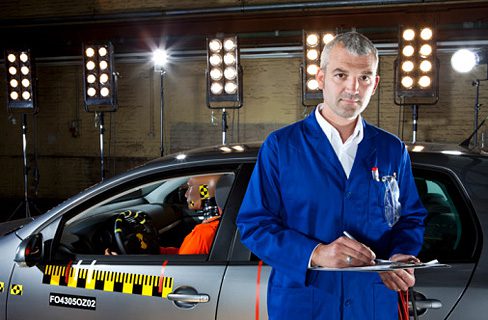The combination of superior design and light-weighting reduces injury and saves lives
Safety is the most important factor in the design and customer choice of a vehicle. The vehicle must protect the driver and passengers in case of an accident, but in addition, it must minimize the consequences of the impact on the crash partner, be it another vehicle, a stationary object or a pedestrian. In the development of the car body structure, it is most important to find a suitable compromise between stiffness, crash performance and further body requirements (e.g. styling, package restrictions, etc.). Aluminium is well suited to reach these goals with maximum performance and the lowest possible mass.
The specific characteristics of aluminium alloys offer the possibility to design cost-effective, lightweight structures with high stiffness and excellent crash energy absorption potential. For optimum protection of the occupants in an accident, vehicles are designed with a stiff and stable passenger cell and surrounding deformation zones where the crash energy can be absorbed.
The mass-specific energy absorption capacity of aluminium is twice that of mild steel and compares favourably to the newly developed high strength steel grades. The high rigidity of an aluminium structure compared to a steel design is the result of the higher material thickness (aluminium components are generally about 50% thicker than steel components fulfilling the same function) and in particular the possibility to use closed multi-hole extrusions and high quality die castings of sophisticated design (which allows the elimination of joints). Depending on the available package space, it is therefore possible to improve the rigidity of the entire structure while still maintaining a weight reduction of up to 40 – 50%. The same principles also apply to pedestrian protection whereproperly designed aluminium front end structures and hoods help to prevent injuries and reduce the fatality risk. Thus car safety is not only a question of the construction material, but, crucially the applied design and assembly concept. As a consequence, aluminium is the preferred material to ensure the safety of the vehicle and its occupants, fulfilling related requirements such as crash compatibility, pedestrian protection, low repair costs, etc.
The safety performance of today’s vehicles is evaluated using different test procedures (e.g. crash tests defined by IIHS in North America or EuroNCAP, EC regulations regarding pedestrian impact, etc.). Aluminium systems exhibit a proven performance record and fulfil all these requirements. The benefits of lightweight car body design with aluminium are demonstrated in a study carried out by Dynamic Research, Inc. for the Aluminum Association (USA) where the crash worthiness and crash compatibility of a typical SUV with other vehicles was examined by numerical simulation. In a first step, the weight of the SUV was reduced by 20%, but the size of the reference vehicle was maintained. In a second step, the size of the SUV was slightly increased, keeping the weight of the reference vehicle. 500 virtual collisions of the SUV were simulated with various crash situations (single vehicle crashes, including rollovers and collisions with fixed objects, such as poles and two vehicle crashes). A combination of passenger car and SUV as well as SUV and SUV crashes was used. When the vehicle was light-weighted, but size remained the same, the injury rate was reduced by 15%. It is important to note that the additional design changes that could be pursued by automakers to mediate impact were not taken into account, nor was the nature of the other cars on the road. When the weight of the vehicle remained the same, but the size was increased, the result is an even higher reduction in injury rate of 26%. Most important is that in two vehicle crashes, the drivers of both vehicles see an improvement in safety.

Safety is the most important factor in the design and customer choice of a vehicle. In the development of the car body structure, it is most important to find a suitable compromise between stiffness, crash performance and further body requirements, such as styling and package restrictions. Aluminium is well suited to reach these goals with maximum performance at the lowest possible mass.